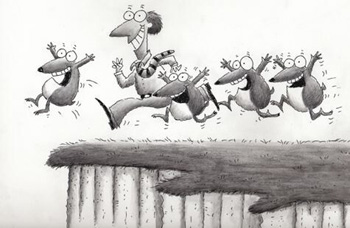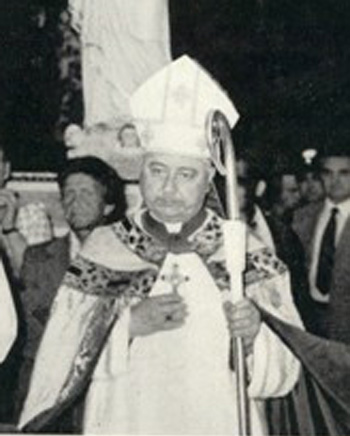Traditionalist Issues
 |
 |
 |
 |
 |
 |
 |
Dialogue Mass - XXIII
How Groupthinking Influenced Pius XII
It is often claimed that Pius XII succumbed to the machinations of liturgical reformers because of illness and infirmity. While these undoubtedly played their part in weakening his resistance, there was another, even greater, factor involved: the insidious power of “groupthink,” which had begun to exercise its malign influence on his policy decisions as early as 1948 when he set up his Commission for the General Reform of the Liturgy with Bugnini at its head.
 “Groupthink” is a term applied to a situation whereby a leader of a nation or an organization makes faulty decisions when pressure from his closest advisors adversely affects his reasoning powers, his ability to evaluate the reality of a situation, and even his moral judgement. From early in his pontificate, Pius XII was a prisoner of precisely that thinking. The signs are clear that his outlook was consistent with the usual symptoms of groupthink:
“Groupthink” is a term applied to a situation whereby a leader of a nation or an organization makes faulty decisions when pressure from his closest advisors adversely affects his reasoning powers, his ability to evaluate the reality of a situation, and even his moral judgement. From early in his pontificate, Pius XII was a prisoner of precisely that thinking. The signs are clear that his outlook was consistent with the usual symptoms of groupthink:
Pius XII gave the reformers unprecedented influence over the manner in which the faithful should participate in the liturgy. The liturgical leaders were the ones to decide not only what the people supposedly wanted, but, more importantly, what they should want. Rome, then, authorized oppressive policies to change their way of participating in the liturgy so that they would conform to the Liturgical Movement’s notion of what was acceptable and what was not.
To the extent that the rule of prayer was replaced by the rule of liturgists, conservative Bishops were forced to do what Pius XII’s Liturgical Commission collectively decided. It is incomprehensible that the Pope could lend countenance to such a group of liturgists whose gross disrespect for Catholic traditions betrayed an equivalent contempt for the Catholic faithful.
The Assisi address presented a false ‘third way’
Pius XII helped to reposition the Liturgical Movement from its originally marginal, even underground status, enabling liturgically progressivist reformers to highjack the center ground and push traditionally-minded Catholics into territory that could then be labeled as “extremist.” He achieved this by the technique of “triangulation,” a strategy often practiced by politicians (2) when faced with difficult dilemmas: They adopt a position both above and between two “extremes.”
In an attempt to transcend both ancient traditions and progressivist reforms, the Pope stated: “One must avoid two extreme attitudes with regard to the past: a blind attachment and a complete contempt.”
And: “On the part of the Church, the liturgy today admits of a preoccupation with progress, but also with conservation and defense.” This is eerily echoed in Vatican II’s Constitution on the Liturgy § 23 where it is stated: “In order that sound tradition be retained, and yet the way remain open to legitimate progress…”
A ventriloquist at work
 It is not generally known that Bugnini was really speaking, for he had already articulated precisely this strategy in 1948 when, as Secretary of the Liturgical Commission, and with the express consent of Pius XII, he published the Memoria Sulla Riforma Liturgica, (3) a document that laid down the fundamental principles by which the intended reform was to proceed.
It is not generally known that Bugnini was really speaking, for he had already articulated precisely this strategy in 1948 when, as Secretary of the Liturgical Commission, and with the express consent of Pius XII, he published the Memoria Sulla Riforma Liturgica, (3) a document that laid down the fundamental principles by which the intended reform was to proceed.
The first principle on the list was that “the opposed claims of the conservative tendency and the innovative tendency must be balanced.”
The dynamics of this triangulated process are easy to comprehend. At the base of the “triangle,” occupying opposite vertices, were the desire for “antiquarianism” (a return to the liturgy of early Christian times) and the desire for innovation (a preference to have only modern vestments, music, language, architecture and rites) .
And at the apex stood Bugnini’s “solution,” which would transcend this polarization by achieving a “synthesis” based on what he called “higher principles.”
Where the hermeneutic of rupture began
But, what about the traditional principles of liturgical development, which had been faithfully observed throughout the Church’s history? These did not even come into the calculus. They were simply cast aside so that Bugnini could proceed with his “synthesis” to produce something essentially different from Catholic Tradition.

 The fact that the Memoria was published with Pius XII’s permission indicates that the Pope allowed Bugnini to dictate the terms of the reform from the start. It was a reform in which, for the first time in the Church’s history, the essentially “conservative tendency” of the liturgy – which was a symbol of a Catholic identity down the ages – would be gradually lost in a merger with the “innovative tendency” in which “change” played a significant role. This was what happened in the 1951-1955 Holy Week reform. It was, therefore, an abandonment of traditional principles on the part of all concerned.
The fact that the Memoria was published with Pius XII’s permission indicates that the Pope allowed Bugnini to dictate the terms of the reform from the start. It was a reform in which, for the first time in the Church’s history, the essentially “conservative tendency” of the liturgy – which was a symbol of a Catholic identity down the ages – would be gradually lost in a merger with the “innovative tendency” in which “change” played a significant role. This was what happened in the 1951-1955 Holy Week reform. It was, therefore, an abandonment of traditional principles on the part of all concerned.
The rhetoric of the Memoria was hollow and its cynicism was manifest. On the one hand, “antiquarianism” did play a role in some of Pius XII’s reforms, as Bugnini intended. On the other hand, the Holy Week liturgy was brought as closely into conformity with contemporary culture as it was possible to do at the time.
Moreover, the progressivists would rise in a very short space of time to occupy the dominant positions inside the structures of ecclesiastical government. Thereby the way was prepared for Tradition to be soon replaced by a new man-made, Bugnini-centric alternative.
Pius XII’s Address left the Catholic faithful completely unaware that the Assisi Congress was really a fig leaf for radical reformers who cared little for the rules that governed the rest of the Church. He presented their campaign as if it really were (as they always claimed) about the salvation of souls and the pastoral needs of the faithful (4) instead of what it really was: a campaign of hostility towards Tradition. In fact, if he had told the truth about them, he could hardly have invited them to Rome for a cordial reception.
Continued


Groupthinking: All run to the abyss with the joy of agreeing with one another
- Even the most outlandish claims were accepted as fact because they concurred with the prevailing prejudice, e.g., that the Holy Spirit was inspiring a Movement whose raison d’être was first to destabilize, then, destroy the Church’s sacred Liturgy, the living source of Catholic spiritual life.
- Pius XII greatly overestimated the integrity of the reformers for whom Catholic traditions were something to be laughed away, shouted down and ignored, not something to be respected, understood or even considered. In his address to the Assisi Congress, he told the participants that it was “a consolation and a joy for us to know that we can rely on your help and your understanding in these matters.”
- Because he viewed their Movement with excessive optimism, he was prepared to ignore the risks of tampering with the liturgy and the potential failure of his policies.
- He seemed to be naively confident that he could manipulate and control the lex orandi to gain a “pastoral” advantage without harming the lex credendi. But it was merely wishful thinking to imagine that the inevitably bad consequences could be averted by adding restrictions, conditions and explanations. (1)
- Separated from reality by his entourage, he promoted the illusion that the faithful joyfully accepted the reforms, and overlooked the high degree of selectivity in information gathering undertaken by Bugnini.
- He did not consult experts (Mgr. Léon Gromier, for instance) who could offer different perspectives nor did he scrutinize the intellectual integrity of the historical research carried out by the reformers.
- In fact, he endorsed the general thrust of the Movement: “The present-day attitude of liturgical milieux towards the past seems to us in general to be entirely sound: There is investigation, serious study, attachment to that which truly deserves it, without, moreover, a falling into excess.”
- Although he was neither forced to innovate nor compelled to make the changes that he authorized, he allowed the Liturgical Movement to become a major weapon in the campaign to challenge traditional values – itself no small reason for the incoherence and gradual breakdown of his government.
Pius XII gave the reformers unprecedented influence over the manner in which the faithful should participate in the liturgy. The liturgical leaders were the ones to decide not only what the people supposedly wanted, but, more importantly, what they should want. Rome, then, authorized oppressive policies to change their way of participating in the liturgy so that they would conform to the Liturgical Movement’s notion of what was acceptable and what was not.
To the extent that the rule of prayer was replaced by the rule of liturgists, conservative Bishops were forced to do what Pius XII’s Liturgical Commission collectively decided. It is incomprehensible that the Pope could lend countenance to such a group of liturgists whose gross disrespect for Catholic traditions betrayed an equivalent contempt for the Catholic faithful.
The Assisi address presented a false ‘third way’
Pius XII helped to reposition the Liturgical Movement from its originally marginal, even underground status, enabling liturgically progressivist reformers to highjack the center ground and push traditionally-minded Catholics into territory that could then be labeled as “extremist.” He achieved this by the technique of “triangulation,” a strategy often practiced by politicians (2) when faced with difficult dilemmas: They adopt a position both above and between two “extremes.”
In an attempt to transcend both ancient traditions and progressivist reforms, the Pope stated: “One must avoid two extreme attitudes with regard to the past: a blind attachment and a complete contempt.”
And: “On the part of the Church, the liturgy today admits of a preoccupation with progress, but also with conservation and defense.” This is eerily echoed in Vatican II’s Constitution on the Liturgy § 23 where it is stated: “In order that sound tradition be retained, and yet the way remain open to legitimate progress…”
A ventriloquist at work

Bugnini - the voice of liturgical reform speaking through Pius XII
The first principle on the list was that “the opposed claims of the conservative tendency and the innovative tendency must be balanced.”
The dynamics of this triangulated process are easy to comprehend. At the base of the “triangle,” occupying opposite vertices, were the desire for “antiquarianism” (a return to the liturgy of early Christian times) and the desire for innovation (a preference to have only modern vestments, music, language, architecture and rites) .
And at the apex stood Bugnini’s “solution,” which would transcend this polarization by achieving a “synthesis” based on what he called “higher principles.”
Where the hermeneutic of rupture began
But, what about the traditional principles of liturgical development, which had been faithfully observed throughout the Church’s history? These did not even come into the calculus. They were simply cast aside so that Bugnini could proceed with his “synthesis” to produce something essentially different from Catholic Tradition.
From the solemn ancient vestments to a modern form promoted by the reform and, finally, everything goes

The rhetoric of the Memoria was hollow and its cynicism was manifest. On the one hand, “antiquarianism” did play a role in some of Pius XII’s reforms, as Bugnini intended. On the other hand, the Holy Week liturgy was brought as closely into conformity with contemporary culture as it was possible to do at the time.
Moreover, the progressivists would rise in a very short space of time to occupy the dominant positions inside the structures of ecclesiastical government. Thereby the way was prepared for Tradition to be soon replaced by a new man-made, Bugnini-centric alternative.
Pius XII’s Address left the Catholic faithful completely unaware that the Assisi Congress was really a fig leaf for radical reformers who cared little for the rules that governed the rest of the Church. He presented their campaign as if it really were (as they always claimed) about the salvation of souls and the pastoral needs of the faithful (4) instead of what it really was: a campaign of hostility towards Tradition. In fact, if he had told the truth about them, he could hardly have invited them to Rome for a cordial reception.
Continued
- A typical example is the permission he had given to the German Episcopal Conference in 1943 for vernacular singing at High Mass, provided that this was strictly confined to Germany. But Cardinal Josef Frings, Archbishop of Cologne and Chairman of the German Episcopate, showed Pius XII what he thought of papal authority when he sang part of the Mass in German at the Assisi Congress in 1956. Also at the same Congress, Archbishop Albert Stohr of Mainz, head of the German Liturgical Commission, threw down the gauntlet to Pius XII when he defiantly declared that the German Bishops would never dispense with vernacular singing at Mass and, furthermore, that it should be extended to the universal Church.
- Some of the most famous practitioners of triangulation were the US Presidents Bill Clinton and Barack Obama, former Senator Hilary Clinton and the UK Prime Minister, Tony Blair with his “New Labor.”
- Bugnini mentioned that only a limited number of copies of the Memoria were published for private circulation among a selected group whom he wished to consult. See A. Bugnini, Reform of the Liturgy, p. 7. Apart from the members of the Liturgical Commission, the first to receive a copy of the Memoria were Dom Bernard Capelle, OSB, Abbot of Mont-César, Fr. Josef Jungmann, SJ, Professor at the University of Innsbruck and Mgr. Mario Righetti, a historian of the liturgy. The Memoria was not published for general readership until 2003. See Carlo Braga, ed., La Riforma Liturgica di Pio XII: Documenti: I. La Memoria sulla Riforma Liturgica, 1948, Rome: Edizioni Liturgiche, 2003.
- The Pope stated: “The Congress that has just concluded was directed to this particular object, to show the inestimable value of the liturgy in the sanctification of souls and consequently in the pastoral activity of the Church.”

Posted August 17, 2015
______________________
______________________
 Volume I |
 Volume II |
 Volume III |
 Volume IV |
 Volume V |
 Volume VI |
 Volume VII |
 Volume VIII |
 Volume IX |
 Volume X |
 Volume XI |
 Special Edition |



